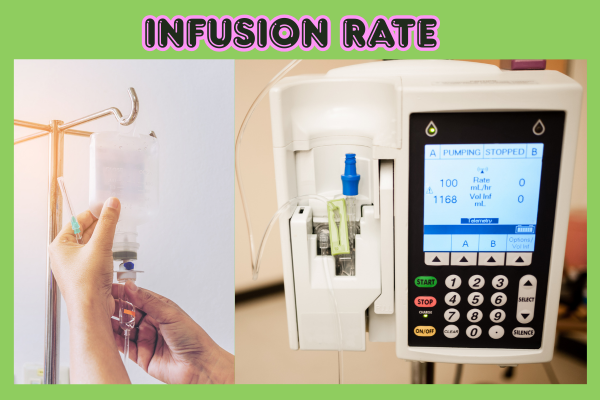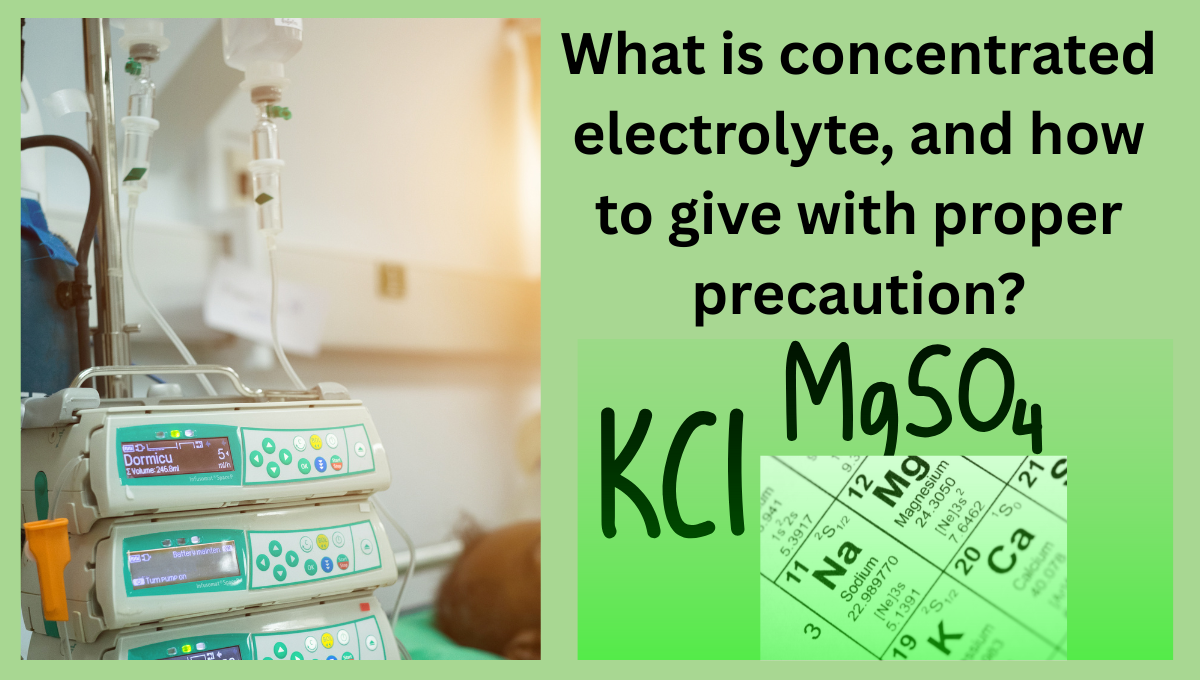What is concentrated electrolyte, and how to give with proper precaution?
An Overview of Electrolytes in Clinical Settings
Minerals called electrolytes are essential for preserving organ function and homeostasis. Intravenous (IV) electrolyte replacement is crucial in clinical settings, particularly for patients who are very sick. However, it’s more complicated than just connecting a bag and letting it run. Clinical judgment, exact technique, and continuous patient monitoring are necessary when administering concentrated electrolyte solutions.
In addition to avoiding medical mistakes, knowing how to provide concentrated electrolytes with the right precautions shields patients against potentially fatal side effects such as respiratory distress or cardiac arrhythmias.

⚗️ Comprehending Concentrated Electrolyte Solutions 🔹 Typical Concentrated Electrolyte Types:
Potassium Chloride (KCl): Usually offered in ampoules of 10–20 mEq/mL.
Calcium chloride: a vesicant with a high osmolarity that requires prudence.
50% solution of magnesium sulfate (500 mg/mL).
In metabolic acidosis, sodium bicarbonate is utilized.
ICU supervision is necessary for hypertonic saline (3% NaCl).
Because of the risk of tissue necrosis, phlebitis, and cardiac arrest, these concentrated electrolytes should never be administered as IV boluses without dilution.
🔹 Electrolyte Replacement Indications
Low potassium levels
Hypomagnesemia
Low levels of calcium
Low blood sugar
Alkalosis or metabolic acidosis
We use the intravenous route when oral administration is not feasible or efficient due to nausea, vomiting, malabsorption, or the severity of the imbalance.
💉 The Significance of IV Electrolyte Replacement
Replacing electrolytes via IV can often save lives. For instance, calcium levels below 7.0 mg/dL can result in seizures or tetany, whereas potassium levels below 3.0 mEq/L may produce arrhythmias. Timely IV electrolyte therapy improves cardiac stability, neuromuscular conduction, and cellular function in emergency and intensive care unit situations.
Extravasation and irritation of the veins
Possible Risks of Inappropriate Cardiac Arrest Administration (particularly from undiluted KCl)
Overcorrection that results in hypermagnesemia and hyperkalemia
Rapid magnesium sulfate infusion-induced respiratory depression
Through rigorous protocol adherence, nurses play a key role in preventing such problems.
Prior to administering electrolytes, a nursing assessment is conducted. Lab results and patient history
Prior to starting IV treatment, make sure:
Levels of serum electrolytes (Na, K, Cl, Mg, and Ca)
Function of the kidneys (BUN, creatinine)
Heart history (ECG if required)
Symptoms of dehydration or fluid overload
Keeping an eye on electrolyte imbalances
Electrolyte imbalances frequently manifest as
cramping or weakening in the muscles
Heartbeat irregularities
Neurological alterations (seizures, confusion)
gastrointestinal symptoms (constipation, nausea)
🧪 Safe IV Electrolyte Handling and Preparation ♗️ Guidelines for Dilution and Compatibility
Chloride of potassium: Maximum 10 mEq/h via peripheral line; in the intensive care unit, 20 mEq/h via central line.
Always dilute in suitable liquids, such as dextrose 5% in water (D5W) or normal saline (NS).
Incompatible electrolytes shouldn’t be used in the same line (calcium + phosphate, for example, can precipitate).
Using Flow Rate Checks and Infusion Pumps
For accuracy, make use of infusion pumps. Make sure:
The rate is appropriately programmed.
The alarms are working.
The site is checked for infiltration or phlebitis.

Safely Giving Particular Electrolytes
🥫 KCl, or potassium chloride
Never administer an IV or undiluted push.
When premixed bags are available, use them.
In order to prevent arrhythmias, administer slowly.
Magnesium sulfate is used to treat torsades de pointes and eclampsia.
Keep an eye out for respiratory depression and hypotension.
💊 Calcium chloride and calcium gluconate
It is safer to use calcium gluconate for peripheral lines.
Use only the central line since calcium chloride is more powerful and vesicant.
❌ Common Errors in Electrolyte Replacement and How to Avoid Them
| Error | Consequence | Prevention |
|---|---|---|
| Giving KCl IV push | Cardiac arrest | Always dilute and use pump |
| Wrong fluid compatibility | Precipitation | Check compatibility chart |
| Overcorrection | Hyperkalemia, seizures | Monitor levels during treatment |

📋 Reporting and Documentation Procedures
Record the patient’s reaction, dosage, route, and rate.
Note the state of the IV site.
Inform the doctor of any negative responses or changes in the lab.
🩺 Monitoring and Follow-Up After Administration
📈 Indications of Adverse Reactions or Overcorrection Bradycardia (with K⁺ or Mg²⁺)
Hypotension, flushing, or tingling
ECG alterations (QT prolongation, elevated T waves)
🗣️ Nurses’ Role in Patient Education: Describe the necessity of electrolytes
Instruct students on how to report symptoms such as palpitations and muscle weakness.
Stress the value of water and lab follow-up.
📘 Clinical Guidelines and Best Practices
To guarantee safe administration, adhere to these:
When feasible, use premixed solutions.
Do not force concentrated electrolytes.
Keep abreast of institutional procedures and evidence-based recommendations.
Consult external recommendations such as the Safe Handling of Concentrated Electrolytes (ASHP) published by the American Society of Health-System Pharmacists.
❓ Electrolyte Replacement FAQs
- Can I administer an IV push of potassium chloride?
No. Never give KCl as an intravenous push. It needs to be gradually diluted and administered using a pump. - What is the highest safe IV potassium rate?
Peripheral lines: 10 mEq/h; central lines: up to 20 mEq/h while being monitored by an ECG. - What symptoms indicate toxicity from magnesium?
hypotension, lack of deep tendon reflexes, respiratory depression, and flushing. - How can I stop the precipitation of calcium and phosphate?
Use distinct lines or schedule at different times instead of administering together. - Why do hospitals keep concentrated electrolytes separately?
to avoid administering boluses by accident, which can be lethal. - Does electrolyte infusion require ECG monitoring?
Yes, particularly when giving magnesium, calcium, or potassium. - Conclusion:
- Improving Patient Outcomes through Safe IV Electrolyte Administration
Concentrated electrolyte administration is a high-alert task that calls for constant monitoring, professional expertise, and attentiveness. IV electrolyte therapy not only restores balance but also saves lives when administered with the right safeguards and according to guidelines. The foundation of this safety chain is nurses, whose knowledgeable decisions have a direct impact on patient safety and rehabilitation.

